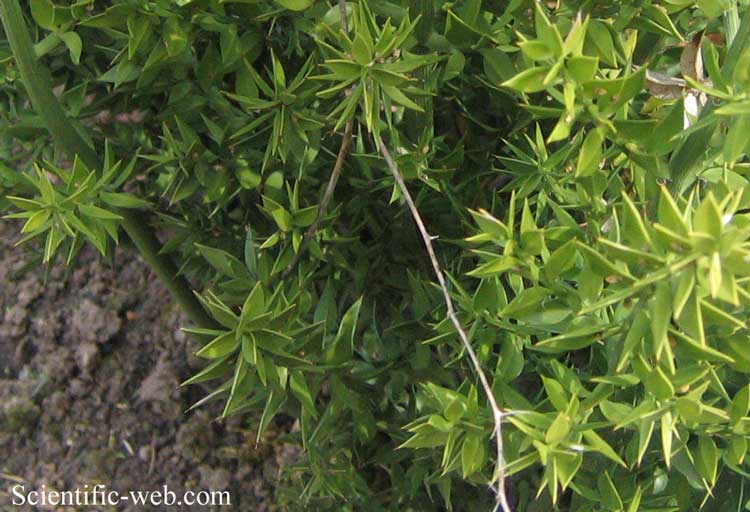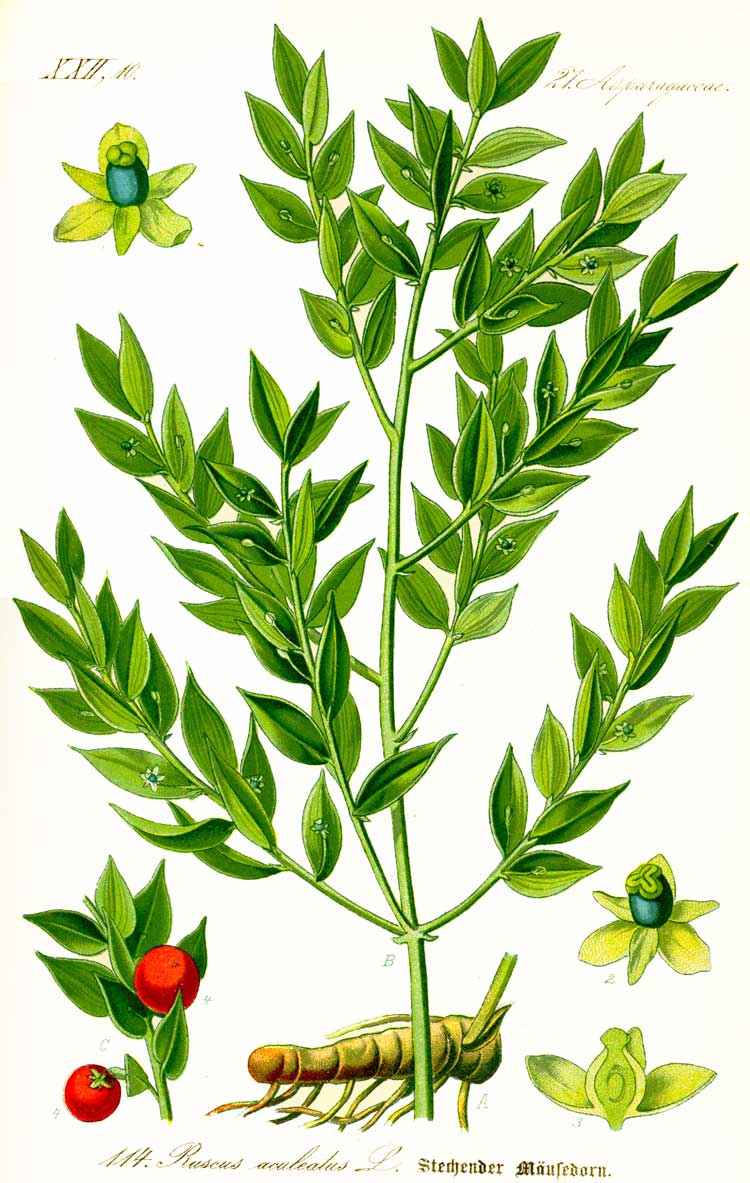
Ruscus aculeatus, Photo: Michael Lahanas
Classification System: APG IV
Superregnum: Eukaryota
Regnum: Plantae
Cladus: Angiosperms
Cladus: Monocots
Ordo: Asparagales
Familia: Asparagaceae
Subfamilia: Nolinoideae
Tribus: Rusceae
Genus: Ruscus
Species: Ruscus aculeatus
Name
Ruscus aculeatus L.

References
Linnaeus, C. 1753. Species Plantarum. Tomus II: 1041. Reference page.
USDA, ARS, Germplasm Resources Information Network. Ruscus aculeatus in the Germplasm Resources Information Network (GRIN), U.S. Department of Agriculture Agricultural Research Service. Accessed: 07-Oct-06.
Vernacular names
български: Бодлив залист
català: Galzeran
corsu: Caracutellu
čeština: listnatec pichlavý
Deutsch: Stechender Mäusedorn
English: Butcher's-broom, Jew's myrtle
Esperanto: Pika rusko
suomi: Pikkuruskus
français: Fragon faux houx
galego: Xilvarveira
hrvatski: Bodljikava veprina
magyar: Szúrós csodabogyó
italiano: Pungitopo
sardu: Frùschiu
Türkçe: Adi tavşanmemesi
vèneto: Bruschi
Ruscus aculeatus, known as butcher's-broom,[2] is a low evergreen dioecious Eurasian shrub, with flat shoots known as cladodes that give the appearance of stiff, spine-tipped leaves. Small greenish flowers appear in spring, and are borne singly in the centre of the cladodes. The female flowers are followed by a red berry, and the seeds are bird-distributed, but the plant also spreads vegetatively by means of rhizomes. It is native to Eurasia and some northern parts of Africa.[3] Ruscus aculeatus occurs in woodlands and hedgerows, where it is tolerant of deep shade, and also on coastal cliffs. Likely due to its attractive winter/spring color, Ruscus aculeatus has become a fairly common landscape plant.[3] It is also widely planted in gardens, and has spread as a garden escapee in many areas outside its native range. The plant grows well in zones 7 to 9 on the USDA hardiness zone map.[3]
The Latin specific epithet aculeatus means “prickly”.[4]
History
Etymology
The common name, butcher's broom, hails from one of its original uses. In Europe, Ruscus species were traditionally harvested for their flat and stiff branches to make small brooms that were used for clearing off and cleaning butchering blocks.[5] Recent research has uncovered that butcher's broom contains some antibacterial compounds.[5] This suggests that in addition to the functional physical properties of Ruscus species, increased effectiveness in cleaning and producing safer products due to unrecognized antibacterial oils may have contributed to its popularity and subsequent nickname.
Traditional medicinal usage
Ruscus aculeatus rhizoma used in traditional medicine
Butcher's broom has been used by a variety of peoples as a treatment for a variety of ailments. A classical remedy from Europe claimed that the rhizomes could be used as a diuretic.[5] In ancient Greece, butcher's broom was used as a laxative or diuretic, and it was also believed to remove kidney stones when added to wine.[6] Butcher's broom was also used to reduce swelling and to speed the recovery of fractures.[7]
Description
Grows to length of 80 cm with stiff branches bearing cladodes (stems modified to look like leaves) and true leaves less than 5 mm. Flowers grow from axils of leaves on adaxial side of cladodes. The 6 tepals are pale green and the ovary and stamens violet. Fruit about 1 cm red, thick and rigid. Flowers in the axil of bracts cladodes up to 4 cm. [8]
Distribution
In Great Britain it has been recorded from southern England to north Wales.[8] In north-eastern Ireland it is extremely rare growing wild but has been recorded in Counties Down and Antrim.[9]
Phytochemicals
Flowers of the plant
The major phytochemicals in butcher's broom are steroidal saponins.[10] Saponins occur naturally in plants as glycosides and have foam forming properties.[11] The specific saponins found in butcher's broom are ruscogenins, ruscogenen and neoruscogenin, named for the genus Ruscus.[5] Ruscogenins function as anti-inflammatory agents[12] and are also believed to cause constriction in veins.[13] Currently the mode of action of ruscogenins is not well understood, but one proposed mechanism suggests that ruscogenins suppresses leukocyte migration through both protein and mRNA regulation.[12] Neoruscogenin has been identified as a potent and high-affinity agonist of the nuclear receptor RORα (NR1F1).[14]
Newer research has also uncovered that there are polyphenols present in butcher's broom which may also be physiologically active, possibly as an antioxidant.[15][16] As of yet there is not enough evidence to make a conclusion, but since they have now been synthesized in labs further research should be in progress.
Cultivars
‘John Redmond’ cultivar
The dwarf cultivar ‘John Redmond’, growing to 50 cm (20 in) tall by 100 cm (39 in) broad, has gained the Royal Horticultural Society’s Award of Garden Merit.[17][18]
Other cultivars include 'Christmas Berry'.[19]
References
The Plant List: A Working List of All Plant Species, retrieved 5 August 2017
BSBI List 2007 (xls). Botanical Society of Britain and Ireland. Archived from the original (xls) on 2015-06-26. Retrieved 2014-10-17.
"Ruscus aculeatus - Plant Finder". www.missouribotanicalgarden.org. Retrieved 2018-11-28.
Harrison, Lorraine (2012). RHS Latin for Gardeners. United Kingdom: Mitchell Beazley. ISBN 978-1845337315.
"HerbalGram: Butcher's Broom". cms.herbalgram.org. Retrieved 2018-11-28.
Abascal, Kathy; Yarnell, Eric (June 2002). "Butcher's Broom: Herb's Potentials Too-Often Swept Under the Rug". Alternative and Complementary Therapies. 8 (3): 177–185. doi:10.1089/107628002760091038. ISSN 1076-2809.
"Butcher's Broom Effectiveness, Safety, and Drug Interactions on RxList". RxList. Retrieved 2018-11-28.
Clapham,A.R., Tutin, T.G. and Warburg, E.F. 1968. Excursion Flora of the British Isles. Cambridge University Press ISBN 0 521 04656 4
Hackney, P. (ed)Stewart & Corry's Flora of the North-east of Ireland. Third Edition The Institute of Irish Studies & Queen's University. Belfast.ISBN 0 85389 446 9
Jakobsson, Hugo; Farmaki, Katerina; Sakinis, Augustinas; Ehn, Olof; Johannsson, Gudmundur; Ragnarsson, Oskar (2018-05-15). "Adrenal venous sampling: the learning curve of a single interventionalist with 282 consecutive procedures". Diagnostic and Interventional Radiology. 24 (2): 89–93. doi:10.5152/dir.2018.17397. ISSN 1305-3612. PMC 5873508. PMID 29467114.
Sahu, N. P.; Banerjee, S.; Mondal, N. B.; Mandal, D. (2008), "Steroidal Saponins", Fortschritte der Chemie organischer Naturstoffe / Progress in the Chemistry of Organic Natural Products, Springer Vienna, vol. 89, pp. 45–141, Bibcode:2008fcon.book...45S, doi:10.1007/978-3-211-74019-4_2, ISBN 9783211740187, PMID 18958994
Huang, Ya-Lin; Kou, Jun-Ping; Ma, Li; Song, Jia-Xi; Yu, Bo-Yang (October 2008). "Possible mechanism of the anti-inflammatory activity of ruscogenin: role of intercellular adhesion molecule-1 and nuclear factor-kappaB". Journal of Pharmacological Sciences. 108 (2): 198–205. doi:10.1254/jphs.08083fp. ISSN 1347-8613. PMID 18946195.
Bouskela, Eliete; Cyrino, Fatima Z. G. A.; Marcelon, Gilbert (August 1993). "Effects of Ruscus Extract on the Internal Diameter of Arterioles and Venules of the Hamster Cheek Pouch Microcirculation". Journal of Cardiovascular Pharmacology. 22 (2): 221–224. doi:10.1097/00005344-199308000-00008. ISSN 0160-2446. PMID 7692161. S2CID 20763763.
Helleboid S, Haug C, Lamottke K, et al. The Identification of Naturally Occurring Neoruscogenin as a Bioavailable, Potent, and High-Affinity Agonist of the Nuclear Receptor RORα (NR1F1). Journal of Biomolecular Screening. 2014;19(3):399-406. https://doi.org/10.1177/1087057113497095.
Herrmann, Josef M.; Untergehrer, Monika; Jürgenliemk, Guido; Heilmann, Jörg; König, Burkhard (2014-04-08). "Synthesis of Phenyl-1-benzoxepinols Isolated from Butcher's Broom and Analogous Benzoxepines". European Journal of Organic Chemistry. 2014 (15): 3170–3181. doi:10.1002/ejoc.201400004. ISSN 1434-193X.
Barbič, Matej; Schmidt, Thomas J.; Jürgenliemk, Guido (June 2012). "Novel Phenyl-1-benzoxepinols from Butcher's Broom (Rusci rhizoma)". Chemistry & Biodiversity. 9 (6): 1077–1083. doi:10.1002/cbdv.201100158. ISSN 1612-1872. PMID 22700226. S2CID 205546309.
"RHS Plantfinder - Ruscus aculeatus 'John Redmond'". Retrieved 11 October 2018.
"AGM Plants - Ornamental" (PDF). Royal Horticultural Society. July 2017. p. 93. Retrieved 11 October 2018.
Gys Petrus de Jong, Ruscus plant named 'Christmas Berry' US PP16680 P2, retrieved 20 July 2016
Retrieved from "http://en.wikipedia.org/"
All text is available under the terms of the GNU Free Documentation License

